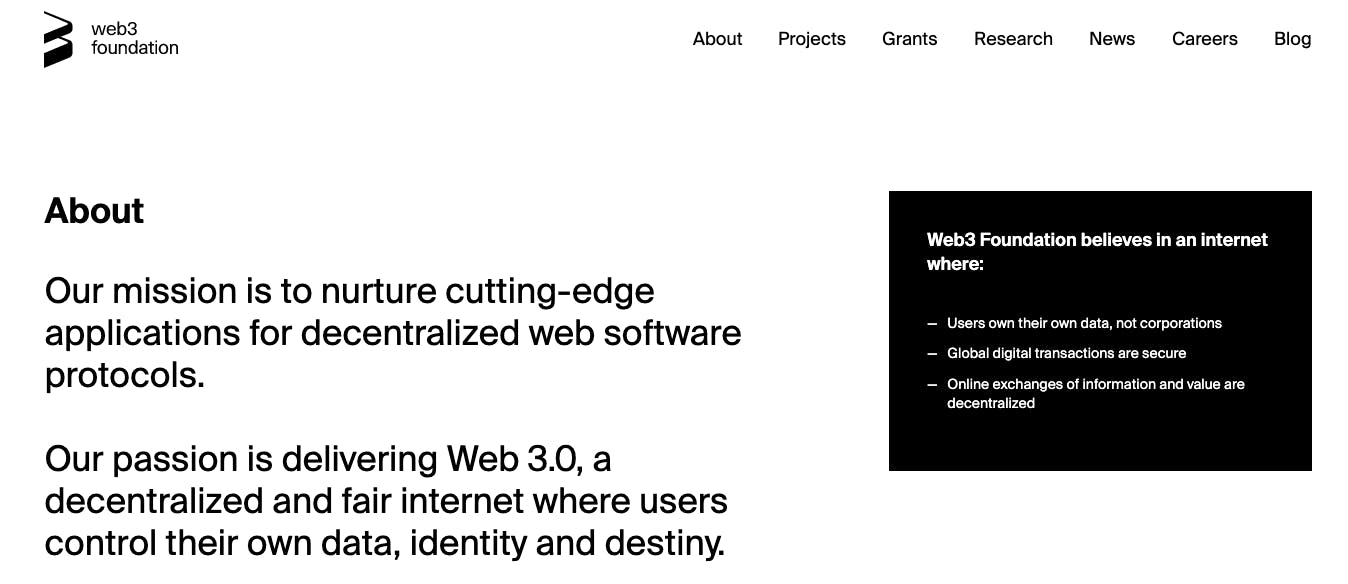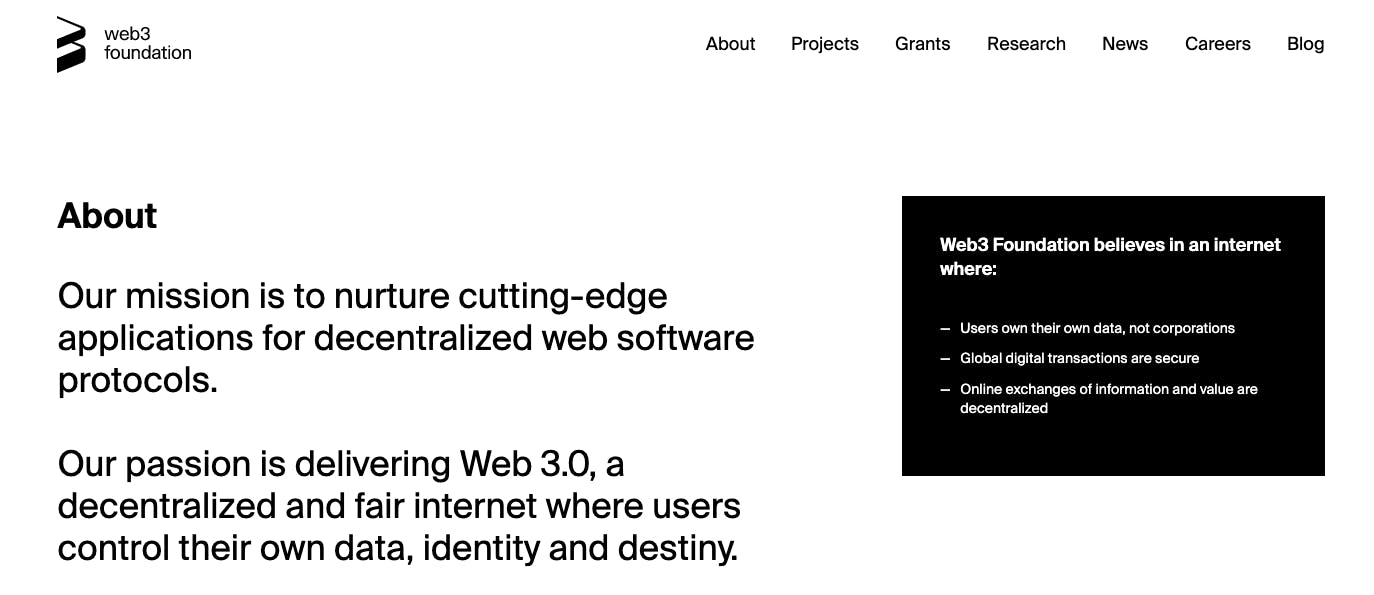The internet has evolved substantially over time.
The Web3 Foundation’s mission and project are becoming increasingly relevant, as there’s a growing interest in a more decentralized web.
Web3, the next generation of the internet, is a decentralized version of the virtual world where people interact and collaborate intelligently.
On the other hand, Web 1.0 and Web 2.0 refer to periods in the history of the web, as they evolved through different formats and technologies.
Web 1.0 refers to the period when most websites were static web pages, and the great majority of users were content absorbers rather than producers.
Web 2.0 focuses on user-generated content shared through social media, networking platforms, blogs, and other web platform services.

In this blog post, we'll go over the history of the Web3 Foundation, its founders, mission, and projects, all of which play an essential role in the blockchain ecosystem.
What is the Web3 Foundation?

The Web3 Foundation was founded to encourage technologies and applications in the disciplines of decentralized web software protocols.
The Web3 Foundation envisions a decentralized internet in which users (not companies) own their data and secure worldwide transactions.
Additionally, the Web3 Foundation supports research and development teams building the decentralized web's technology stack.
Now that we know what Web3 Foundation is, that isn't enough, right? Let's proceed to the following section, where we'll discuss their technology stack.
Web3 Technology Stack
The Web3 technology stack has multiple layers from layer0 to layer4.

Layer0: This Layer consists of platforms that use a zero/low trust interaction protocol, such as Polkadot, to allow all participants to share security.
It also includes a networking suite that allows decentralized nodes to communicate and run the same software across multiple physical platforms (architectures, OSes, etc.). Examples are EVM (Ethereum), UTXOs (Bitcoin), and Polkadot.
Layer1: This layer allows data distribution and interaction. A protocol describes how various nodes can interact and trust each other's computation and information.
It also utilizes transient data pub/sub messaging, which describes how non-persistent data, such as status updates, is communicated and how nodes are made aware of its presence.
Most cryptocurrencies, such as Bitcoin and ZCash, are Zero/Low Trust Interaction Protocols.
Layer2: This layer extends Layer 1's capabilities by enabling features like enhanced scale, encrypted messaging, and distributed networks.
Layer3: This layer of human-readable languages and tools enables programmers to write programs at the appropriate abstraction level.
Solidity and Vyper (Ethereum), Plutus (Cardano), and Rust (Solana) are examples of Protocol-extensible developer APIs and languages that are used to develop apps without dealing with actual bytecode (Substrate). Additionally, tools such as ethers.js, web3.js, and oo7.js are available to create applications that easily interface with a blockchain.
Layer4: This layer has the ability for any user on the internet to interact with one or more blockchains. Examples are MetaMask, and MyCrypto, among others.
Who's Behind the Web3 Foundation?
Polkadot creator and Ethereum co-founder Gavin Wood introduced the phrase "Web3" in 2014. Dr Aeron Buchanan and Reto Trinkler are also the Web3 Foundation council members.
Dr. Gavin Wood is the originator of the Web3 Foundation and currently serves on the board of directors of Parity Technologies Ltd.
He has co-founded multiple technological firms and invented cutting-edge analysis tools and programming languages.
Dr Gavin Wood has given talks to audiences worldwide, ranging from keynotes at regional technology conferences to Harvard's musings on the future of judicial institutions. He graduated from the University of York with a PhD in Computer Science.
He was the Ethereum Project's chief technology officer and co-founder. Dr Wood created and maintained the Solidity programming language, served as the IDE's project manager, and devised and implemented the Whisper protocol.
He is a co-creator of the Ethereum Protocol, the author of its formal specification, and the first functioning Ethereum implementation creator.
In 2014, Dr. Aeron Buchanan, a member of the web3 Foundation council, became a mathematical modeler for the Ethereum project.
After working as an algorithm designer for the special-effects industry, he got his doctorate from Oxford University's Robotics Department in the field of computer vision. For his bachelor's degree, he studied engineering and computer science.
He's worked as a consultant to economics and ecological research institutions, designing algorithms for unmanned aerial vehicles and founding digital companies that make light-show controllers and blockchain technology.
He presently serves as an advisor to several significant blockchain initiatives to improve consensus platform technology and bring its advantages to society and the economy more quickly.
Reto Trinkler, another council member of the web3 Foundation, co-founded a blockchain-based platform that allows users to create, manage, and invest in technology-regulated digital investment funds.
He has been building Ethereum smart contracts since the platform's creation, with a background in mathematics from ETH Zurich.
Mr. Trinkler has previously created a winning trading algorithm in C++ for sports betting platforms.
What is the Mission of the Web3 Foundation?
The mission of the Web3 Foundation is to deliver Web 3.0, a decentralized and fair internet in which individuals control their data, identity, and fate.
Also, to foster cutting-edge applications for decentralized web software protocols.
Web 3.0 is a collection of protocols that serve as building blocks for application developers. Traditional web technologies are replaced by these building blocks, which present an entirely new approach to developing apps.
These technologies provide users with solid and verifiable assurances regarding the information they receive, give away, and pricing. We can ensure that censorship and monopolization have fewer hiding spots by allowing users to act for themselves within low-barrier markets.
According to Dr. Gavin Wood, the Ethereum Co-founder, said:
The adoption of Web 3.0 will be neither fast nor clean. With entrenched interests controlling much of our digital lifestyles and interests often aligned between lawmakers, government, and technology monopolists (consider how the NSA's Prism program enlisted the help of Facebook and Google), some jurisdictions may even attempt to make components of the new web illegal. Already Russia has outlawed bitcoin, and the U.K. has expressed a (ridiculous) desire to criminalize strong cryptography.
Where is the Web3 Foundation located?
Web 3.0 Technologies Stiftung is in the Data Processing, Hosting, and Related Services industry and is based in Zug, ZUG, Switzerland. They employ five people and generate over $300,000 in revenue (USD).
The Web 3.0 Technologies Stiftung corporate family consists of two entities where the Key Principal is Kasper Joergensen, and the other team includes Bertrand Perez (Managing Director), Gavin James Wood(President), and Aeron Morgan Buchanan(Vice President).
Web3 Foundation Projects
Polkadot was the Web3 Foundation's inaugural initiative founded by some of the blockchain industry's foremost builders, such as Robert Habermeier, Dr Gavin Wood, Peter Czaban.
It's designed to connect private and consortium chains, public and permissionless networks, oracles, and yet-to-be-developed technologies.
Through the Polkadot relay chain, Polkadot facilitates an internet where separate blockchains can communicate information and transactions in a trustless manner.

Kusama is another core project of the web3 Foundation. It’s a scalable network of specialized blockchains developed using Substrate and virtually the same codebase as Polkadot. The network provides an experimental development environment for companies looking to move quickly and innovate on Kusama or prepare for Polkadot deployment.
Gavin Wood, the founder of Polkadot & the co-founder and former CTO of Ethereum, launched Kusama in 2019.

Conclusion
In this blog article, we explored the Web3 Foundation's history, including its founders, mission, and projects, as well as the evolution of things over time.
To discover more about blockchain, NFTs, NFT artists, Crypto, and other web3 topics, Kindly visit the Hashnode web3 blog.


